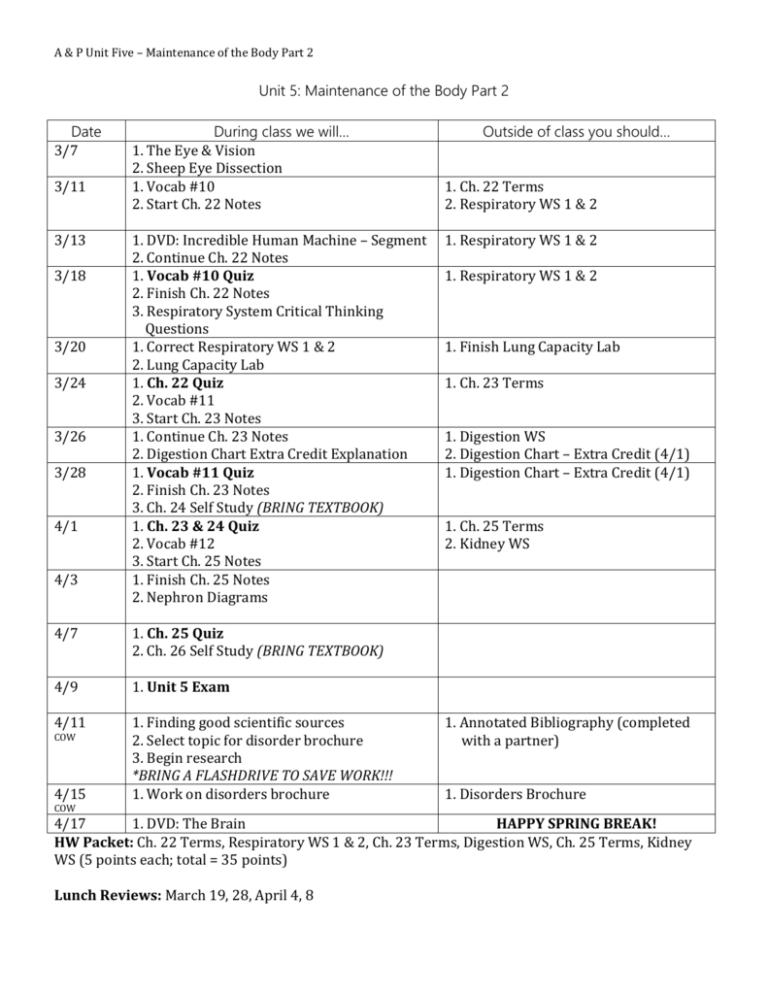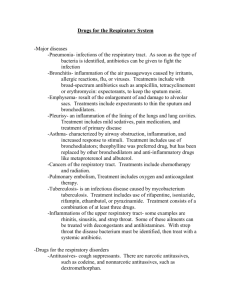A & P Unit Five – Maintenance of the Body Part 2 Unit 5
advertisement

A & P Unit Five – Maintenance of the Body Part 2 Unit 5: Maintenance of the Body Part 2 Date 3/7 3/11 3/13 3/18 3/20 3/24 3/26 3/28 4/1 4/3 During class we will… 1. The Eye & Vision 2. Sheep Eye Dissection 1. Vocab #10 2. Start Ch. 22 Notes 1. DVD: Incredible Human Machine – Segment 2. Continue Ch. 22 Notes 1. Vocab #10 Quiz 2. Finish Ch. 22 Notes 3. Respiratory System Critical Thinking Questions 1. Correct Respiratory WS 1 & 2 2. Lung Capacity Lab 1. Ch. 22 Quiz 2. Vocab #11 3. Start Ch. 23 Notes 1. Continue Ch. 23 Notes 2. Digestion Chart Extra Credit Explanation 1. Vocab #11 Quiz 2. Finish Ch. 23 Notes 3. Ch. 24 Self Study (BRING TEXTBOOK) 1. Ch. 23 & 24 Quiz 2. Vocab #12 3. Start Ch. 25 Notes 1. Finish Ch. 25 Notes 2. Nephron Diagrams 4/7 1. Ch. 25 Quiz 2. Ch. 26 Self Study (BRING TEXTBOOK) 4/9 1. Unit 5 Exam 4/11 1. Finding good scientific sources 2. Select topic for disorder brochure 3. Begin research *BRING A FLASHDRIVE TO SAVE WORK!!! 1. Work on disorders brochure COW 4/15 COW Outside of class you should… 1. Ch. 22 Terms 2. Respiratory WS 1 & 2 1. Respiratory WS 1 & 2 1. Respiratory WS 1 & 2 1. Finish Lung Capacity Lab 1. Ch. 23 Terms 1. Digestion WS 2. Digestion Chart – Extra Credit (4/1) 1. Digestion Chart – Extra Credit (4/1) 1. Ch. 25 Terms 2. Kidney WS 1. Annotated Bibliography (completed with a partner) 1. Disorders Brochure 4/17 1. DVD: The Brain HAPPY SPRING BREAK! HW Packet: Ch. 22 Terms, Respiratory WS 1 & 2, Ch. 23 Terms, Digestion WS, Ch. 25 Terms, Kidney WS (5 points each; total = 35 points) Lunch Reviews: March 19, 28, April 4, 8 A & P Unit Five – Maintenance of the Body Part 2 Chapter 22 – The Respiratory System 1. Identify the organs forming the respiratory passageway(s) in descending order until the alveoli are reached. 2. Describe the location, structure, and function of each of the following: nose, paranasal sinuses, pharynx, and larynx. 3. List and describe several protective mechanisms of the respiratory system. 4. Distinguish between conducting and respiratory zones. 5. Describe the makeup of the respiratory membrane, and relate structure to function. 6. Explain the importance of the partial vacuum that exists in the intrapleural space. 7. Relate Boyle’s law to the events of inspiration and expiration. 8. Explain the relative roles of the respiratory muscles and lung elasticity in producing the volume changes that cause air flow into and out of lungs. 9. List several physical factors that influence pulmonary ventilation. 10. Explain and compare the various lung volumes and capacities. 11. Define dead space. 12. Indicate types of information that can be gained from pulmonary function tests. 13. State Dalton’s law of partial pressures and Henry’s law. 14. Describe how atmospheric and alveolar air differ in composition, and explain these differences. 15. Relate Dalton’s and Henry’s law to the events of external and internal respiration. 16. Describe how oxygen is transported in the blood, and explain how oxygen loading and unloading is affected by temperature, pH, BPG, and PCO2. 17. Describe carbon dioxide transport in the blood. 18. Describe neural controls of respiration. 19. Compare and contrast the influences of arterial pH, arterial partial pressures of oxygen and carbon dioxide, lung reflexes, volition, and emotions on respiratory rate and depth. 20. Compare and contrast the hyperpnea of exercise with hyperventilation. 21. Describe the process and effects of acclimatization to high altitude. 22. Compare the causes and consequences of chronic bronchitis, emphysema, asthma, tuberculosis, and lung cancer. 23. Trace the embryonic development of the respiratory system. 24. Describe normal changes that occur in the respiratory system from infancy to old age. Chapter 22 Terms 1. respiratory zone 2. conducting zone 3. pharynx 4. larynx 5. epiglottis 6. alveoli 7. atmospheric pressure 8. partial pressure 9. expiration 10. intrapulmonary pressure 11. intrapleural pressure 12. Boyle’s law 13. tidal volume 14. total lung capacity 15. vital capacity 16. residual volume 17. inspiration Chapter 22 Suggested Reading: pp. 805-839, 839-843 Chapter 23 – The Digestive System 1. Describe the function of the digestive system, and differentiate between the organs of the alimentary canal and accessory digestive organs. 2. List and define the major processes occurring during digestive system activity. 3. Describe the tissue composition and the general function of each of the four layers of the alimentary canal. 4. Describe the gross anatomy and the basic functions of the mouth. pharynx, and esophagus. 5. Describe the composition and functions of saliva, and explain how salivation is regulated. 6. Explain the dental formula and differentiate clearly between deciduous and permanent teeth. 7. Describe the mechanisms of chewing and swallowing. A & P Unit Five – Maintenance of the Body Part 2 8. Identify structural modifications of the wall of the stomach that enhance the digestive process. 9. Name the cell types responsible for secreting the various components of gastric juice and indicate the importance of each component in stomach activity. 10. Identify structural modifications of the wall of the small intestine that enhance the digestive process. 11. Differentiate between the roles of the various cell types of the intestinal mucosa. 12. State the role of bile in digestion and describe how its entry into the small intestine is regulated. 13. Describe the role of the gallbladder. 14. State the role of pancreatic juice in digestion. 15. Describe how pancreatic juice into the small intestine is regulated. 16. List the major functions of the large intestine. 17. Describe the regulation of defecation. 18. List the enzymes involved in chemical digestion; name the foodstuffs on which they act. 19. List the end products of protein, fat, carbohydrate, and nucleic acid digestion. 20. Describe the process of absorption of breakdown products of foodstuffs that occurs in the small intestine. 21.Describe the embryonic development of the digestive system. 22. Describe abnormalities of the gastrointestinal tract at different stages of life. Chapter 23 Terms 1. alimentary canal 2. digests 3. peristalsis 4. mucosa 5. lamina propria 6. submucosa 7. serosa 8. bolus 9. chyme 10. bile Chapter 23 Suggested Reading: pp. 851-854, 856(Histology of the Alimentary Canal)-871, 877-901; 901-905 Chapter 24 – Nutrition, Metabolism, and Body Temperature Regulation – SELF STUDY 1. Define nutrient, essential nutrient, and calorie. 2. List the six major nutrient categories. Note the important sources and main cellular uses. 3. Distinguish between simple and complex carbohydrates. 4. Indicate the major uses of carbohydrates in the body. 5. Indicate the uses of fats in the body. 6. Distinguish between saturated, unsaturated, and trans fatty acids. 7. Distinguish between nutritionally complete and incomplete proteins. 8. Indicate uses of proteins in the body. 9. Define nitrogen balance and indicate possible causes of positive and negative nitrogen balance. 10. Distinguish between fat- and water-soluble vitamins, and list the vitamins in each group. 11. For each vitamin, list important sources, body functions, and important consequences of its deficit or excess. 12. List minerals essential for health; indicate important dietary sources and describe how each is used. 13. Explain what is meant by body energy balance. 14. Describe some theories of food intake regulation. 15. Define metabolic rate and total metabolic rate. Name factors that influence each. 16. Distinguish between core and shell body temperature. 17. Describe how body temperature is regulated, and indicate the common mechanisms regulating heat production/retention and heat loss from the body. 18. State and describe the three theories of obesity causes. 19. State and describe treatments for obesity. 20. What is the only “good” treatment for obesity? Chapter 24 Terms – None for this Chapter Chapter 24 Suggested Reading: pp. 911-918; 944-954 Chapter 25 – The Urinary System A & P Unit Five – Maintenance of the Body Part 2 1. Describe the gross anatomy of the kidney and its coverings. 2. Trace the blood supply through the kidney. 3. Describe the anatomy of a nephron. 4. Describe the forces (pressures) that promote or counteract glomerular filtration. 5. Compare the intrinsic and extrinsic controls of the glomerular filtration rate. 6. Describe the mechanisms underlying water and solute reabsorption from the renal tubules into the peritubular capillaries. 7. Describe how sodium and water reabsorption is regulated in the distal convoluted tubule. 8. Describe the importance of tubular secretion and list several substances that are secreted. 9. Describe the mechanisms responsible for the medullary osmotic gradient. 10. Explain formation of dilute versus concentrated urine. 11. Describe the normal and chemical properties of urine. 12. List several abnormal urine components, and name the condition characterized be the presence of detectable amounts of each. 13. Describe the general location, structure and function of the ureters. 14. Describe the general location, structure, and function of the urinary bladder. 15. Describe the general location, structure, and function of the urethra. 16. Compare the course, length, and functions of the male urethra with those of the female. 17. Define micturition and describe its neural control. Chapter 25 Terms 1. renal cortex 2. renal medulla 3. nephron 4. filtrate 5. afferent arteriole 6. efferent arteriole 7. glomerular hydrostatic pressure 8. countercurrent mechanism 9. antidiuretic hormone 10. micturition Chapter 25 Suggested Reading: pp. 961-988 Chapter 26 – Fluid, Electrolyte, and Acid-Base Balance – SELF STUDY 1. List the factors that determine body water content and describe the effect of each factor. 2. Indicate the relative fluid volume and solute composition of the fluid compartments of the body. 3. Contrast the overall osmotic effects of electrolytes and nonelectrolytes. 4. Describe factors that determine fluid shifts in the body. 5. List the routes by which water enters and leaves the body. 6. Describe feedback mechanisms that regulate water intake and hormonal controls of water output in urine. 7. Explain the importance of obligatory water loss. 8. Describe possible causes and consequences of dehydration, hypotonic hydration, and edema. 9. Indicate the routes of electrolyte entry and loss from the body. 10. Describe the importance of ionic sodium in fluid and electrolyte balance of the body , and indicate its relationship to normal cardiovascular functioning. 11. Describe mechanisms involved in regulating sodium balance, blood volume, and blood pressure. 12. Explain how potassium, calcium, and anion balance in plasma are regulated. 13. List the three major chemical buffer systems of the body and describe how they resist pH changes. 14. Describe the influence of the respiratory system on acid-base balance. 15. Describe how the kidneys regulate hydrogen and bicarbonate ion concentration in the blood. Chapter 26 Terms – None for this Chapter Chapter 26 Suggested Reading: pp. 995-1014









